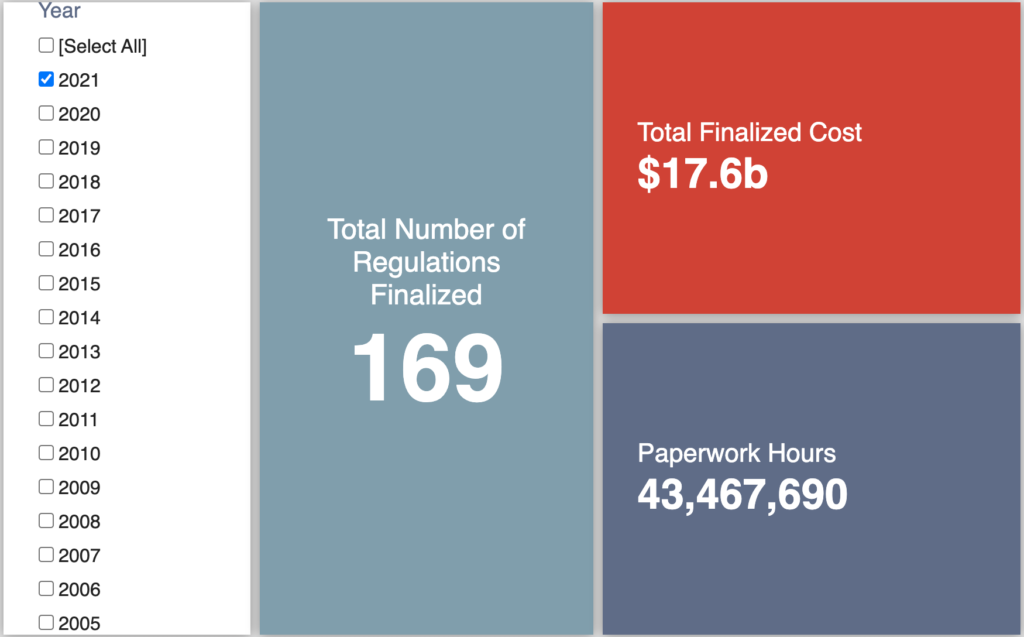Week in Regulation
August 16, 2021
$150 Billion Vehicle Emissions Rule Tops Year So Far
This week was highlighted by an Environmental Protection Agency (EPA) proposed rule that, by a factor of about 15, is the costliest rule published so far in the Biden Administration. In fact, it is the most expensive proposed rule the American Action Forum (AAF) has tracked going back to 2005. Across all rulemakings, agencies published $149.2 billion in total net costs and added 1 million paperwork burden hours.
REGULATORY TOPLINES
- Proposed Rules: 56
- Final Rules: 65
- 2021 Total Pages: 45,545
- 2021 Final Rule Costs: $17.6 billion
- 2021 Proposed Rule Costs: $135 billion
NOTABLE REGULATORY ACTIONS
The EPA’s “Revised 2023 and Later Model Year Light-Duty Vehicle Greenhouse Gas Emissions Standards” proposed rule is the largest rule, by net economic impact, published yet by the Biden Administration. The proposed rule modifies emissions limits requirements for model year 2023-2026 vehicles. The agency estimates total costs of $150 billion through 2050 if the rule is finalized as proposed. The EPA justifies these costs on the basis that it expects the net benefits of the rule to be $86 billion once fuel savings and emissions reduction benefits are factored in. The rule modifies the Trump Administration’s 2020 rule that was the largest deregulatory rule of the 45th president’s term.
With a rule that large, the rest of the week paled in comparison. But in terms of final rules, the largest of the week was a Department of Agriculture (USDA) rule implementing a provision of the 2018 Farm Bill that “provides loans to eligible entities to relend with the purpose of assisting heirs with undivided ownership interests resolve ownership and succession issues on farms that are owned in common by multiple heirs.” That rule is estimated to cost $869 million.
TRACKING THE ADMINISTRATIONS
As we have already seen from executive orders and memos, the Biden Administration will surely provide plenty of contrasts with the Trump Administration on the regulatory front. And while there is a general expectation that the new administration will seek to broadly restore Obama-esque regulatory actions, there will also be areas where it charts its own course. Since the AAF RegRodeo data extend back to 2005, it is possible to provide weekly updates on how the top-level trends of President Biden’s regulatory record track with those of his two most recent predecessors. The following table provides the cumulative totals of final rules containing some quantified economic impact from each administration through this point in their respective terms.
This week’s largest shift comes from the Biden Administration, which added nearly $1 billion to its total costs tally, largely due to the USDA rule mentioned above. The most notable change from the previous administrations was a $176 million jump from the Trump Administration, which stemmed from two notable rules – one from the Federal Communications Commission and one from the EPA.
THIS WEEK’S REGULATORY PICTURE
By Rose Laoutaris, Regulatory Policy Intern
This week, President Biden directs federal agencies to accelerate a transition to lower-emission vehicles.
In the August 10 edition of the Federal Register, the Executive Office of the President published Executive Order (EO) 14,037, Strengthening American Leadership in Clean Cars and Trucks.
The EO created a goal that by 2030, 50 percent of new passenger cars and light trucks sold should be zero-emission vehicles. Such vehicles include battery electric, plug-in hybrid electric, and fuel-cell electric vehicles.
The EO orders the EPA to begin working on rulemaking under the Clean Air Act to create multi-pollutant emissions standards, including standards for greenhouse gas emissions and light- and medium-duty vehicles that would begin in 2030, and oxides of nitrogen standards for heavy-duty engines and vehicles beginning with model year 2027 through at least 2030. The EO created targets for a notice of proposed rulemaking for rules surrounding standards of nitrogen oxides for heavy-duty engines and vehicles to be issued by January 2022 and final rulemaking by December 2022. The target for final rulemakings surrounding rules on greenhouse gas emissions and light- and medium-duty vehicles is no later than July 2024.
The EO also orders the Department of Transportation (DOT) to begin working on rulemaking under the Energy Independence and Security Act of 2007 to create fuel efficiency standards for passenger cars and light-duty trucks beginning with model year 2027 through at least model year 2030, and heavy-duty pickup trucks and vans beginning with model year 2028 through at least model year 2030. The target date set by the EO for final rulemakings surrounding these rules is also no later than July 2024.
Finally, the EO calls for the secretary of Transportation and the administrator of the EPA to work with the secretaries of Commerce, Labor, and Energy to achieve these goals, in addition to the state of California, which President Biden noted in the order as having “significant expertise and historical leadership…with respect to establishing emissions standards for light-, medium-, and heavy-duty vehicles.”
TOTAL BURDENS
Since January 1, the federal government has published $152.6 billion in total net costs (with $17.6 billion in new costs from finalized rules) and 32.8 million hours of net annual paperwork burden increases (with 43.5 million hours in increases from final rules).












